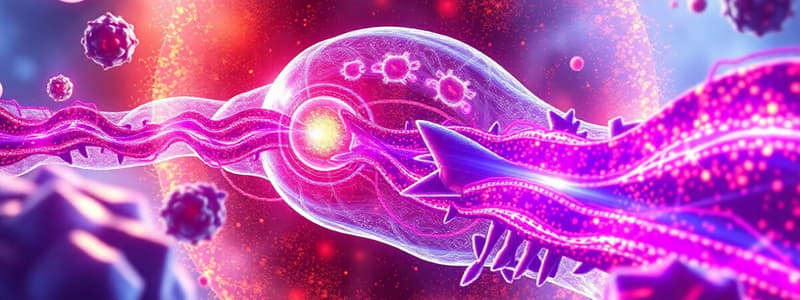Podcast
Questions and Answers
What is the primary role of the sodium-potassium pump in cell transport mechanisms?
What is the primary role of the sodium-potassium pump in cell transport mechanisms?
- To enable glucose uptake into cells
- To facilitate the bulk transport of substances
- To transport large molecules across capillary walls
- To maintain a concentration gradient for Na⁺ and K⁺ (correct)
Which transport mechanism is characterized by cotransport using the sodium gradient?
Which transport mechanism is characterized by cotransport using the sodium gradient?
- Secondary active transport (correct)
- Vesicular exocytosis
- Endocytosis
- Transcytosis
What type of vesicular transport involves the uptake of solid particles into the cell?
What type of vesicular transport involves the uptake of solid particles into the cell?
- Endocytosis
- Pinocytosis
- Phagocytosis (correct)
- Receptor-mediated endocytosis
What is the importance of transcytosis in cellular transport mechanisms?
What is the importance of transcytosis in cellular transport mechanisms?
What is the mechanism of receptor-mediated endocytosis?
What is the mechanism of receptor-mediated endocytosis?
Flashcards
Primary Active Transport
Primary Active Transport
A transport system that uses energy directly from ATP hydrolysis (like the sodium potassium pump) to move substances against their concentration gradient. This process is vital for establishing and maintaining concentration gradients across cell membranes.
Secondary Active Transport
Secondary Active Transport
A transport system that relies on the energy stored from an existing concentration gradient to move other substances. This energy is typically derived from the movement of ions like sodium down their electrochemical gradient.
Vesicular Transport
Vesicular Transport
The bulk movement of molecules into or out of cells using membrane-bound vesicles. This process is essential for transporting large quantities of substances, including proteins and lipids.
Endocytosis
Endocytosis
Signup and view all the flashcards
Exocytosis
Exocytosis
Signup and view all the flashcards
Study Notes
Active Transport
-
Primary active transport example: Sodium-potassium pump
- Each cycle exports 3 sodium ions (Na⁺) and imports 2 potassium ions (K⁺) into the cell
- Maintains a concentration gradient, with more K⁺ inside the cell and more Na⁺ outside
- Crucial for electrically excitable cells (muscle and nerve cells)
-
Secondary active transport example: Sodium-glucose transporter (SGLT)
- Cotransport: Kinetic energy of one substance (sodium moving down its gradient) powers the transport of another substance (e.g., glucose)
- Sodium moves into the cell down its concentration gradient, and glucose "hitches a ride" into the cell
- ATP is used to maintain the sodium gradient
Vesicular Transport
- Enables cells to obtain or expel bulk quantities of substances
- Vesicles envelope substances
- Endocytosis: Movement into the cell.
- Phagocytosis: Moves solids into the cell
- Pinocytosis: Moves liquids into the cell
- Receptor-mediated endocytosis: Receptors on the cell membrane bind molecules and bring them into the cell (e.g., cholesterol transport)
- Exocytosis: Movement of molecules out of the cell
- Secretions
- Replaces sections of membrane
Transcytosis
- Endocytosis → exocytosis: Moves substances through the cell
- Particularly important in transporting plasma proteins (like insulin) across capillary walls when substances are too large to pass through channels directly.
Studying That Suits You
Use AI to generate personalized quizzes and flashcards to suit your learning preferences.




